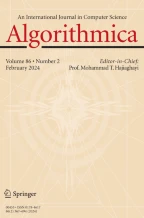Abstract
An on-line algorithm is presented for constructing the suffix tree for a given string in time linear in the length of the string. The new algorithm has the desirable property of processing the string symbol by symbol from left to right. It always has the suffix tree for the scanned part of the string ready. The method is developed as a linear-time version of a very simple algorithm for (quadratic size) suffixtries. Regardless of its quadratic worst case this latter algorithm can be a good practical method when the string is not too long. Another variation of this method is shown to give, in a natural way, the well-known algorithms for constructing suffix automata (DAWGs).
Similar content being viewed by others
References
A. Aho and M. Corasick, Efficient string matching: an aid to bibliographic search,Comm. ACM,18 (1975), 333–340.
A. Amir and M.Farach, Adaptive dictionary matching,Proc. 32nd IEEE Ann. Symp. on Foundations of Computer Science, 1991, pp. 760–766.
A. Apostolico, The myriad virtues of subword trees, inCombinatorial Algorithms on Words (A. Apostolico and Z. Galil, eds.), Springer-Verlag, New York, 1985, pp. 85–95.
A. Blumer, J. Blumer, D. Haussier, A. Ehrenfeucht, M. T. Chen, and J. Seiferas, The smallest automaton recognizing the subwords of a text,Theoret. Comput. Sci.,40 (1985), 31–55.
M. Crochemore, Transducers and repetitions,Theoret. Comput. Sci.,45 (1986), 63–86.
M. Crochemore, String matching with constraints, inMathematical Foundations of Computer Science 1988 (M. P. Chytil, L. Janiga and V. Koubek, eds.), Lecture Notes in Computer Science, vol. 324, Springer-Verlag, Berlin, 1988, pp. 44–58.
Z. Galil and R. Giancarlo, Data structures and algorithms for approximate string matching,J. Complexity,4 (1988), 33–72.
M. Kempf, R. Bayer, and U. Güntzer, Time optimal left to right construction of position trees,Acta Inform.,24 (1987), 461–474.
E. McCreight, A space-economical suffix tree construction algorithm,J. Assoc. Comput. Mach.,23 (1976), 262–272.
E. Ukkonen, Constructing suffix trees on-line in linear time, inAlgorithms, Software, Architecture. Information Processing 92, vol. I (J. van Leeuwen, ed.), Elsevier, Amsterdam, 1992, pp. 484–492.
E. Ukkonen, Approximate string-matching over suffix trees, inCombinatorial Pattern Matching, CPM '93 (A. Apostolico, M. Crochemore, Z. Galil, and U. Manber, eds.), Lecture Notes in Computer Science, vol. 684, Springer-Verlag, Berlin 1993, pp. 228–242.
E. Ukkonen and D. Wood, Approximate string matching with suffix automata,Algorithmica,10 (1993), 353–364.
P. Weiner, Linear pattern matching algorithms,Proc. IEEE 14th Ann. Symp. on Switching and Automata Theory, 1973, pp. 1–11.
Author information
Authors and Affiliations
Additional information
Communicated by K. Mehlhorn.
This research was supported by the Academy of Finland and by the Alexander von Humboldt Foundation (Germany).
Rights and permissions
About this article
Cite this article
Ukkonen, E. On-line construction of suffix trees. Algorithmica 14, 249–260 (1995). https://doi.org/10.1007/BF01206331
Received:
Revised:
Issue Date:
DOI: https://doi.org/10.1007/BF01206331
